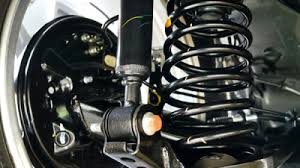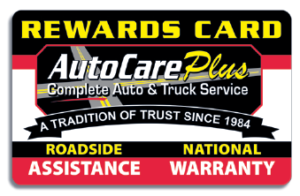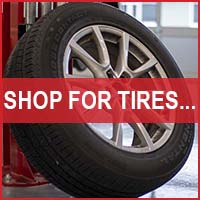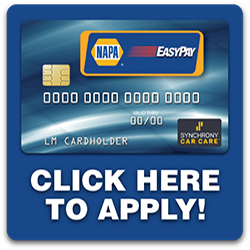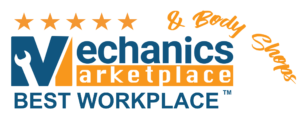Steering, Shocks, Struts & Suspension
Improve your vehicle’s handling, increase tire life, and drive with safety by having your steering and suspension components inspected by one of our ASE certified technicians. Also, checking your tires every month to insure that they are inflated with the right amount of air pressure.
The purpose of your vehicle’s suspension is to maximize tire traction by keeping the vehicles tires in contact with the road surface. It also provides steering stability with good handling and will ensure the comfort of the passengers.
Major components that make up this system are your vehicle’s:
Struts, shocks, springs and steering gear (either a steering box or a rack and pinion style system) and hydraulic steering pump. To maximize life expectancy of these systems you should have some periodic maintenance performed.
Power Steering System Service
Power steering fluid is the most overlooked automotive fluid. Changing your vehicle’s power steering fluid along with adding a fluid conditioner every 2 years or 30,000 miles is required to ensure the soft seals and hoses do not deteriorate causing leaks which can lead to hydraulic steering pump failure and rack and pinion failure. Very inexpensive maintenance to prevent thousands of dollars in repairs. Click here for animation and video explanations of your steering system.
Shock and Strut Replacement
The average shock or strut compresses 75 Million times in 50,000 miles! Shocks wear out in as little as 50,000 miles and should be replaced no later than 60,000 miles. Struts wear out in as little as 60,000 miles and should be replaced no later than 90,000 miles.
Worn out shocks and struts adversely affect stability, braking and traction of your vehicle.
If a road were perfectly flat, with no irregularities, suspensions wouldn’t be necessary. But roads are far from flat. Even freshly paved highways have subtle imperfections that can interact with the wheels of a car. It’s these imperfections that apply forces to the wheels. A bump in the road causes the wheel to move up and down perpendicular to the road surface. The magnitude, of course, depends on whether the wheel is striking a giant bump or a tiny speck. Either way, the car wheel experiences a vertical acceleration as it passes over an imperfection.
Without an intervening structure, all of wheel’s vertical energy is transferred to the frame, which moves in the same direction. In such a situation, the wheels can lose contact with the road completely. Then, under the downward force of gravity, the wheels can slam back into the road surface. What you need is a system that will absorb the energy of the vertically accelerated wheel, allowing the frame and body to ride undisturbed while the wheels follow bumps in the road. This is the job of the shock and or strut. Worn out shocks and struts are unable to keep the tire in constant contact with the road surface which can cause loss of control of the vehicle. This is especially true in wet road conditions when water/snow gets under the tire causing hydroplaning. A very dangerous situation. Other side affects of the tire constantly losing contact with the road surface is what is called “cupping” of your tires. This can best be described as high and low spots over the surface of your tire which leads to premature tire wear and vehicle vibrations.
Click here for a complete animation and video showing how your shocks and struts work.
Any time the vehicles steering or suspension components are changed a wheel alignment will be required.
Alignment Service
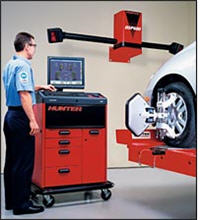 Proper alignment is necessary for even tread wear and precise steering. A misaligned vehicle will also affect your gas mileage. Vehicle alignment should be checked every 6 months and should have an alignment performed at least once per year or every 12,000 miles.
Proper alignment is necessary for even tread wear and precise steering. A misaligned vehicle will also affect your gas mileage. Vehicle alignment should be checked every 6 months and should have an alignment performed at least once per year or every 12,000 miles.
Q. How important is wheel alignment?
A. Research indicates that the average car is driven about 12,000 miles per year. A car with toe alignment just 0.34 degrees (Just 0.17 inches) out of specification has dragged its tires sideways for more than 68 miles by the end of the year!
Q. What are the symptoms of a car that’s out of alignment?
A. Have your car checked if you notice:
- Excessive or uneven tire wear.
- Steering wheel pulls to the left or right.
- Feeling of looseness or wandering.
- Steering wheel vibration or shimmy.
- Steering wheel is not centered when car is moving straight ahead.
Many vehicles today are equipped with rear suspensions that can be adjusted for alignment. Our ASE certified alignment technicians can tell you if your vehicle requires a two or four wheel alignment. With our state-of-the-art computerized alignment machines we will also provide you with a computer printout showing the adjustments that were made to your vehicle.
The most common adjustable angles are:
Toe
This refers to the tilted direction of the wheels toward or away from one another when viewed from the front. Toe is the most critical tire-wearing angle. Tires that “toe-in” point toward one another. Tires that “toe-out” point away from each other.
Camber
This refers to the tilt of the wheels toward or away from one another when viewed from the top. Wheels that tilt in toward the vehicle have “negative camber.” Wheels that tilt away from the vehicle have “positive camber.”
Caster
This refers to the angle of the steering axis in relation to an imaginary vertical line through the center of the wheel when viewed from the side. “Positive caster” is the term used when the vertical line is tilted back toward the rear. If it’s tilted forward, we call it “negative caster.” The proper caster angle stabilizes your car for better steering.
Thrust Angle This refers to the relationship of all four wheels to each other, as well as their relationship to an imaginary centerline that runs from bumper to bumper. The term “thrust line” refers to the direction in which the rear wheels are pointed. Thrust angle is correctable on cars with adjustable rear suspensions. If your car has a non-adjustable suspension, thrust-angle is compensated for by aligning the front wheels to the rear wheels.
Why Four Wheel Alignment?
Reduced Tire Wear
Improper alignment is a major cause of premature tire wear. Over the years, a properly aligned vehicle can add thousands of miles to tire life.
Better Gas Mileage
Gas mileage increases as rolling resistance decreases. Total alignment sets all four wheel parallel which, along with proper inflation, minimizes rolling resistance.
Improved Handling
Does your car pull to one side? Does the steering wheel vibrate? Do you constantly have to move the steering wheel to keep your car traveling straight ahead? Many handling problems can be corrected by total alignment. With all the system components aligned properly, road shock is more efficiently absorbed for a smoother ride.
Front End Inspection
A suspension system inspection is part of our alignment procedure. This allows us to spot worn parts before they cause costly problems.
Wheel alignments should be checked at least once per year or anytime you have your tires replaced. We would be happy to set up an appointment for you to check your wheel alignment. Our Free local courtesy shuttle can take you to work, home or to the local shopping mall! Otherwise, you can always reserve one of our complimentary loaner cars!

